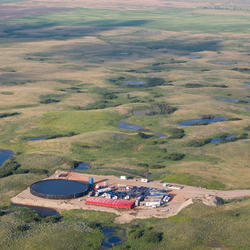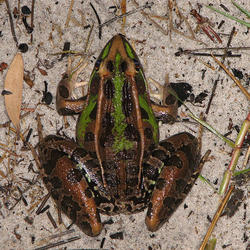Exposure Pathways
Exposure Pathways
Filter Total Items: 82
Ecotoxicology and Ecological Risks of Per‐ and Polyfluoroalkyl Substances
Ecotoxicology and ecological risks of per- and polyfluoroalkyl substances are summarized to highlight critical gaps and uncertainties, and to provide potential approaches to fill those gaps, including the development of targeted monitoring programs and cross-disciplinary approaches.
Scientists Provide an Understanding of Anticoagulant Rodenticide Exposure in Non-Target Bird Species
U.S. Geological Survey scientists and their partners utilize laboratory and field studies and existing information to improve understanding of anticoagulant rodenticide exposure and effects to wild birds.
Advanced PFAS Measurement Methods
Environmental Health Program scientists, in collaboration with other USGS scientists, are developing complementary field and laboratory methods and capabilities to detect and quantify a range of target and nontarget per- and polyfluoroalkyl substances (PFAS) and indicator compounds at low levels (parts per trillion) in a variety of environmental matrices. The PFAS Integrated Science Team is...
Energy Integrated Science Team
The Energy Lifecycle Integrated Science Team focuses on the potential for contaminant exposures in the environment that might originate from energy resource activities including, extraction, production, transportation, storage, extraction, waste management and restoration. Perceived health risks to humans and other organisms will be distinguished from actual risks, if any. If actual risks are...
Bioaccumulation of Mercury in Fish Varied by Species and Location in the Chesapeake Bay Watershed—Summary of Existing Data and a Roadmap for Integrated Monitoring
Fish mercury data from State monitoring programs and research studies within the Chesapeake Bay were compiled and summarized to provide a comprehensive overview of the variation in fish mercury concentrations among species and habitats within the watershed. These data are put into context with existing health benchmarks for humans, birds, and fish. Scientists also provide a roadmap for an...
Flood Redistributes Mercury in Grand Canyon Aquatic Food Webs
S cientists coupled the concepts of energy flow through food webs with measurements of mercury in organic matter and animals to estimate mercury fluxes and fate during an experimental flood in the Colorado River. The flood redistributed mercury in simple, upstream food webs but not in more complex, downstream food webs.
Science to Understand Low-Level Exposures to Neonicotinoid Pesticides, their Metabolites, and Chlorinated Byproducts in Drinking Water
Scientists reported the discovery of three neonicotinoid pesticides in drinking water and their potential for transformation and removal during water treatment. The research provides new insights into the persistence of neonicotinoids and their potential for transformation during water treatment and distribution, while also identifying granulated activated carbon as a potentially effective...
Clothianidin Exposure Associated with Changes in Tadpole Behavior
During a laboratory exposure study, tadpole movement decreased with increased concentrations of clothianidin, a neonicotinoid pesticide. Decreased movement could affect a tadpole’s ability to forage, escape predation, and metamorphose before ponds dry.
Bird Hatchling Development Following Exposure to Environmentally Relevant Levels of Brominated Flame Retardants
Scientists performed laboratory studies with American kestrels and zebra finch to determine the effects of brominated flame retardant exposure on hatchlings. They found evidence that exposure while in the egg disrupted thyroid function in female American kestrel hatchlings and affected nestling body condition in zebra finch hatchlings, but no other effects were detected.
Dragonfly Larvae are Effective Bioindicators of Mercury Exposure in Fish and Amphibians—Results of Citizen Science in 100 National Parks and Protected Places
Mercury concentrations were measured in dragonfly larvae across more than 450 sites in 100 national parks and protected places as part of a partnership among Federal agencies, academic researchers, and more than 4,000 citizen scientists. Mercury concentrations in dragonfly larvae were positively correlated with mercury concentrations in fish and amphibians living in the same aquatic environments...
U.S. Geological Survey Microbiologist Selected as an American Society for Microbiology Distinguished Lecturer
Dale Warren Griffin, a U.S. Geological Survey (USGS) environmental public-health microbiologist, was selected as a Waksman Foundation Distinguished Lecturer for the 2020–22 American Society for Microbiology (ASM) Lecture Series.
Framework for Examining Stream Ecosystem Health in Areas of Shale Gas Development—A Multi-Parameter Watershed-Based Case Study in Pennsylvania
In a case study of 25 headwater streams in Pennsylvania, no statistically significant associations were determined between shale gas development and geochemical tracers of produced waters or measures of microbial and macroinvertebrate community composition. Although the results are specific to the region studied, the integrated biological and geochemical framework provides a tool for examining...













